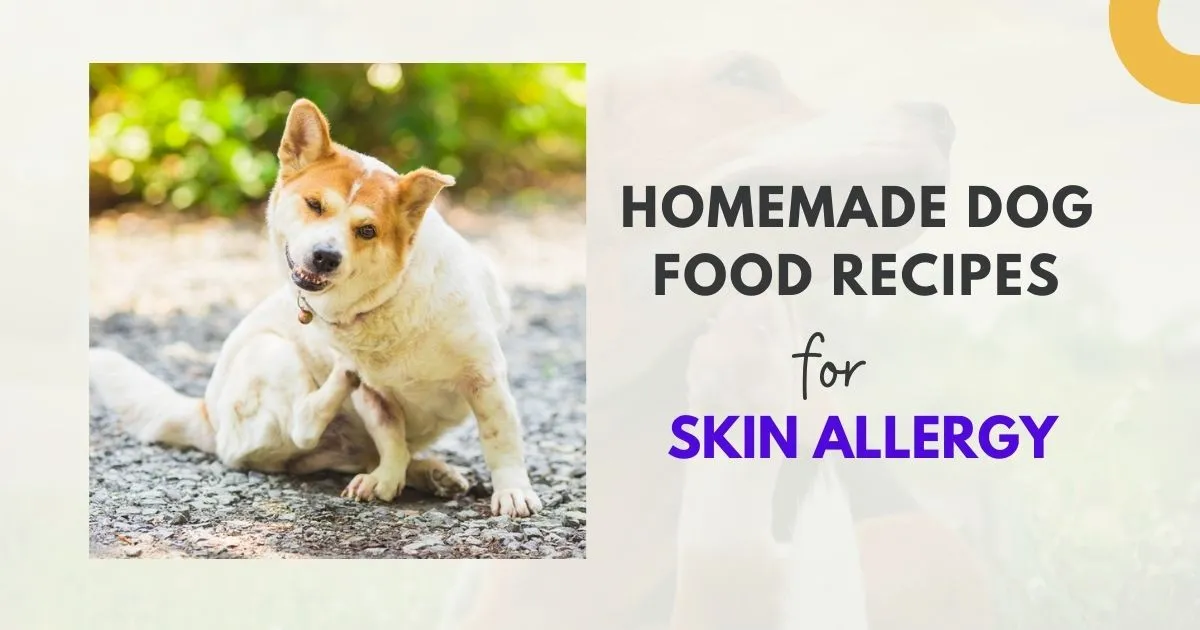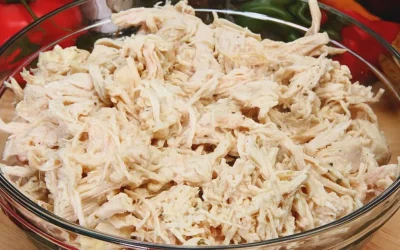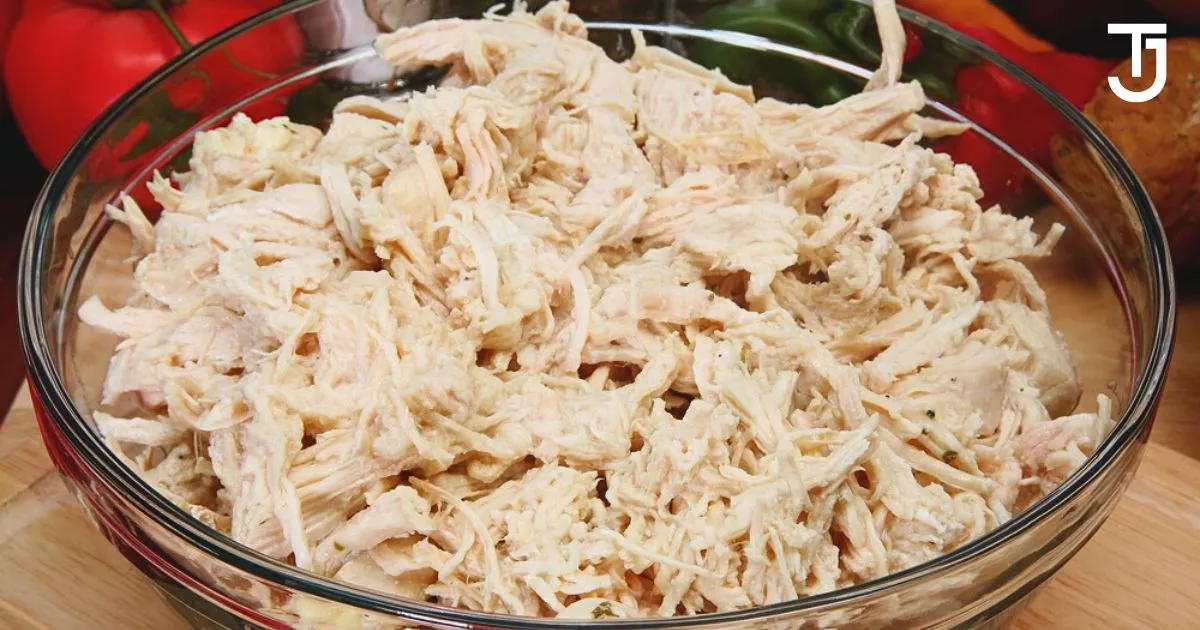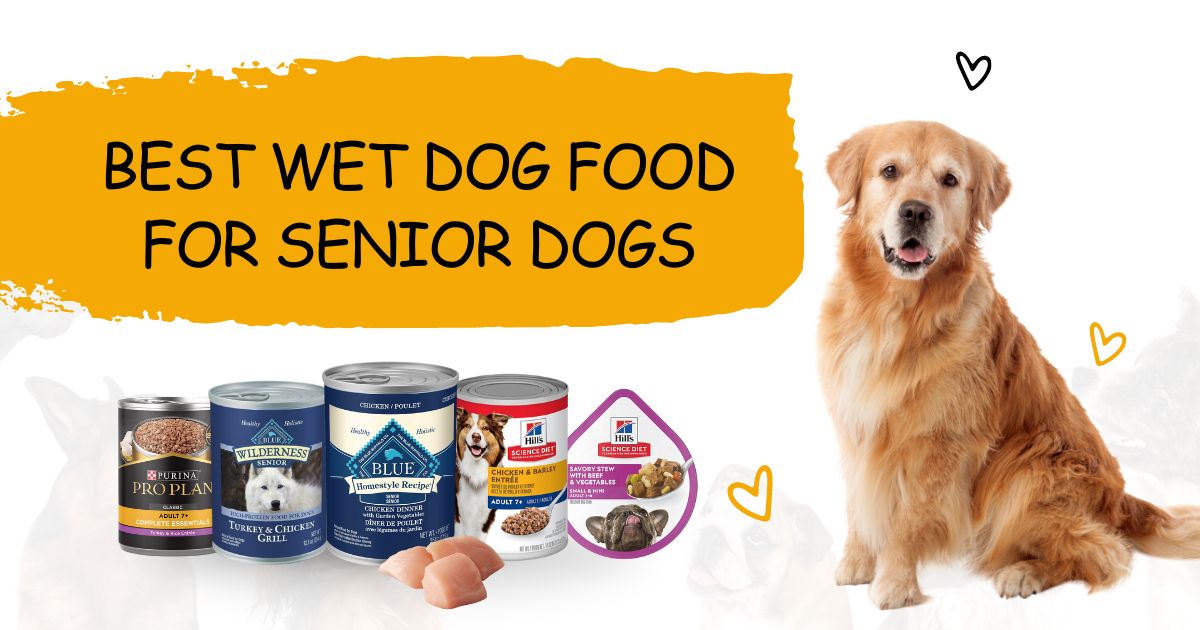10 Homemade Dog Food recipes for Dogs with Allergies

Every pet owner loves their pets and wants to ensure the best healthy care possible. Our in-house bulldog, Harley, is no exception. Unfortunately, like many other dog breeds, Bulldogs are lying to skin allergies. After comprehensive experimentation, we discovered a selection of nutritious and homemade recipes that have significantly improved Harley’s well-being. His recovery has been outstanding, and now we’re eager to share ten delicious homemade dog food for skin allergies to improve your dog’s well-being today.
UNDERSTANDING SKIN ALLERGIES IN DOGS

Skin allergies in dogs are common but unpleasant conditions that can be brought on by food, natural allergens, or bug bites. Dogs with skin awareness could experience steady, itchy, dull illnesses, baldness, redness, and self-injury. “To investigate and treat skin responsive qualities”, it is required to see a veterinarian who can analyze the specific allergen and suggest a reasonable solution or diet. Using skin or oral justifying medications, immunotherapy, or avoiding the allergen can control skin allergies.
WHAT NUTRIENTS ARE ESSENTIAL FOR DOGS WITH ALLERGIES?
Concerning support for canines with sensitivities, nutrients can help relieve symptoms and promote well-being for dogs with allergies. Here are some key things you should follow:
1. Novel Proteins:
Novel proteins probably won’t make your dog allergic because they come from protein sources. These kinds of proteins can be found in a lot of various foods, like venison, rabbit, and duck. There is a smaller chance that your dog has already been introduced to these sources since they aren’t usually in traditional dog food. These new proteins may help your dog’s allergic symptoms more than the usual allergens that are in most dog food. This diet plan might work best for pets that have eating problems or allergies. Feeling better and having a better life can come from it.
2. Omega-3 Fatty Acids:
These fatty acids are very important for keeping skin healthy and shiny because they reduce inflammation. Because they help with general health and shine, they also ease the pain of skin problems. Flaxseeds and fatty fish like salmon are especially high in omega-3 fatty acids. Both can be easily added to a healthy diet to get these benefits.
3. Antioxidants:
A strong immune system and natural pain relief are two very important benefits of antioxidants. Eating lots of fruits and vegetables will keep your pet healthy. Blueberries and veggies both have many vitamins and antioxidants. Doing this on a regular basis can help your dog stay healthy and fight off health problems.
4. Limited Ingredients:
It is very easy to find and eliminate allergens on limited-ingredient diets. This is especially useful for dogs that have food issues or allergies. Maintaining the toxins to a minimum makes it easier to find the ones hurting the dogs. Special dog food ensure they get all the ingredients they need and no extra allergens that could make their allergies worse. Eating this manner helps dogs with allergic reactions and makes their immune systems stronger by giving them a clean, well-balanced diet.
Consider these vital nutrients to help control skin allergies, reduce irritation, and support your dog’s healthy skin and coat. Talk to a vet or pet nutritionist to ensure your dog’s diet is balanced and meets his unique needs.
HOW DOES HOMEMADE FOOD ALLEVIATE SKIN ALLERGIES IN DOGS?
Custom-made dog food can be a remarkable answer for treating skin sensitivities or bothersome skin. By getting ready dinners at home, you deal with the fixings, allowing you to fit the food to your dog’s particular necessities. A few key advantages include:
- Customization: You can pick sensitivity-acceptable fixings.
- Freshness: Hand-crafted food stays away from additives.
- Variety: Turn proteins and grains to forestall responsive qualities. Make sure to counsel your veterinarian for direction.
TOP 10 HOMEMADE DOG FOOD FOR SKIN ALLERGIES
1. Chicken Goulash:
Ingredients:
- Two chicken breasts
- 1 cup chopped potatoes, broccoli, carrots, and green beans
- 1/4 cup rolled oats
- 2 cups chicken broth
- Frying oil
Directions:
- Cook the chicken, rice, and veggies individually.
- Transfer them into a large bowl and stir until well combined.
2. Doggie Meat Loaf:
Ingredients:
- 3 cups meat (e.g., beef, turkey, or chicken)
- Two eggs
- 1/2 cup chopped or grated vegetables
- 1/2 cup of cottage cheese
- 1/2 cup rolled oats
Directions:
- Mix all the ingredients and make a bread shape
- Place them in a cooking container with potatoes.
- Bake at 175°C (350°F) for 80 minutes.
3. Chicken and Rice:
Ingredients:
- 1/4 pound cooked, skinless chicken
- 1 cup of brown rice
- 1 cup of peas and carrots
- One tablespoon of vegetable oil
- 1/4 teaspoon potassium chloride
Directions:
- Cook the chicken, rice, and vegetables together.
- Add the veggies last, just before the meat is fully cooked.
4. Turkey and Vegetable Dinner:
Ingredients:
- 1-pound ground turkey
- 1 cup cooked brown or white rice
- 1/2 cup of green beans
- 1/2 cup of carrots
- 1/4 cup of water
- 1-2 tablespoons vegetable oil
Directions:
- Cook the turkey, rice, and veggies together.
- Add the vegetables last, just before the meat is ready.
5. Simple Raw Dog Food:
Ingredients:
- 1.5 cups raw meat (e.g., beef, chicken, or fish)
- 1 cup mixed vegetables (carrots, romaine lettuce, squash, Brussels sprouts, etc.)
- One tablespoon of cod liver oil
- One tablet supplement
- Two tablespoons of bone meal or another calcium supplement
Directions:
- Mix all ingredients and serve.
6. Raw Fish Dinner:
Ingredients:
- 2 pounds of fish fillets
- One can of pink salmon
- Two eggs
- Four tablespoons of parsley
- Two tablespoons of oregano
- One tablespoon of bone meal
- 1/2 cup of cooked rice
Directions:
- Mix all ingredients and serve.
7. Turkey Rosemary Dog Food:
Ingredients:
- One lb. ground turkey
- 1 cup of frozen vegetables
- 1 cup of cooked rice
- One teaspoon of dried rosemary
Directions:
- Cook the ground turkey.
- Add frozen vegetables, cooked rice, and dried rosemary.
- Mix well and serve.
8. Wheat-Free Healthy Dog Food:
Ingredients:
- 2 1/2 cups of brown rice flour
- Two tablespoons of flaxseed
- Two extra-large eggs (lightly beaten)
- 3/4 cup canned pumpkin puree
- 1/4 cup cold water (or enough to make the dough stick)
Directions:
- Preheat the oven to 350°F.
- Mix brown rice flour and flax seed.
- Mix eggs and pumpkin until smooth.
- Add pumpkin mixture to the flour mixture.
- Gradually add water to form a dough.
- Roll out the dough and cut out the biscuits.
- Bake until firm.
9. Simple Chicken and Vegetable:
Ingredients:
- Lean ground chicken
- Spinach
- Zucchini
- Peas
Directions:
- Cook ground chicken.
- Add spinach, zucchini, and peas.
- Mix well and serve.
10. Sweet Potato and Salmon Stew:
Ingredients:
- One lb. salmon fillet (cooked and flaked)
- 2 cups sweet potatoes (peeled and cubed)
- 1 cup green beans (chopped)
- 1/4 cup fresh parsley (chopped)
- Two tablespoons of olive oil
- 2 cups water or low-sodium chicken broth
Directions:
- Mix sweet potatoes, green beans, and water (or chicken broth) in a large pot.
- After bringing to a boil, reduce the heat and simmer for 15 minutes or until the sweet potatoes are soft.
- Add the cooked salmon, parsley, and olive oil.
- Stir well and let it cool before serving.
WHICH INGREDIENTS ARE HARMFUL IN DOG FOOD?
When selecting the proper dog food, it is crucial to be aware of certain ingredients that may not benefit your pet. Here are some regular dog food fixings to keep away from:
Corn:
Dogs shouldn’t be scared of corn, but many commercial dog foods apply it as a cheap filler. It’s not advised for dogs to eat this sod because it lacks the minerals and vitamins they need. Most of the time, this is true. Corn has a lot of carbs, which can make dogs gain weight for no reason. If you don’t take care of your dog’s diabetes properly, it can get more serious, so this may make them more likely to get it. Anyone who owns a dog and wants to keep them healthy should learn more about the nutrients in their dog food.
Artificial Preservatives:
Ethoxyquin, BHA (Butylated Hydroxyanisole), and BHT (Butylated Hydroxytoluene) generally added to dog food to make it last longer. Because these substances have been shown in several studies to cause cancer, people who work in animal health are very worried about how they will affect dogs’ health in the long run. The toxins in question have been shown to make dogs sick, which is not limited to liver and kidney issues. This could hurt their overall health and shorten their lives.
By-Products:
Aside from organs and bones, these items sometimes include diseased tissues and tumors that are not safe for humans to eat. People sometimes call them “meat by-products” or “poultry by-products.” When compared to whole foods, these parts are not nearly as healthy for dogs and may lead to a number of ongoing health issues. Understanding ingredient labels on dog food is important to keep our dogs healthy.
Added Sugars:
There are a lot of sugars added to commercial dog foods to make them taste better and appeal to dogs’ likes. As with people, though, these extra sugars can be very bad for dogs’ health. Having too many calories can make you gain weight, which is a usual problem. Sugar in their food also causes dental problems, like cavities and gum disease. Along with this, eating a lot of high-sugar foods raises your risk of getting diabetes, which can cause long-term health problems. Sugar is also very bad for dogs, but so are fake sweeteners, especially xylitol. Acute low blood sugar, liver failure, and even death can happen from even small amounts of xylitol. Dog owners need to be aware of these risks, pick foods that are healthy for their dogs, and extend their lives without using additives that are bad for them.
Fake Tones and Flavors:
Synthetic substances enhance food appearance and taste to attract consumers. Flavouring or colouring dishes attract dogs. Improved human and dog sensory capacities can create allergies and other health issues. Diet and sensitivity affect dog and human toxic reactions. It may exacerbate minor allergies. Dogs seek unnutritional food.
HOW DO I KNOW IF MY DOG HAS A SKIN ALLERGY?

When identifying skin allergies in dogs, there are a few signs to keep an eye out for. These include extreme tingling, rash, facial swelling, red and puffy skin, stomach issues, wheezing, watery eyes, irritating ears, and consistent licking. Remember that every dog is unique; talking with your veterinarian is crucial when choosing the right nourishment for your pet. Prioritize high-quality proteins, natural carbohydrates, and healthy fats to keep your dog healthy and blissful!
WHAT ARE THE STEPS TO SWITCH MY DOG’S DIET EFFECTIVELY?
To prevent digestive problems, you must regularly introduce a new diet to your dog. Follow these moves to guarantee a straightforward change:
Consult your vet: Consult your veterinarian before rolling out any dietary improvements. They can offer specific instructions in light of your canine’s singular requirements. Pick the New Eating Routine: Make your meals or buy commercial dog food of high quality. Guarantee the new eating routine meets your canine’s dietary basics.
Change Period:
- In the first week, combine a small amount—about 25%—of the new food with the current food for your dog.
- Week 2: Increase the amount of new food to around half.
- Week 3: Raise it to 75% new and 25% old food.
- Week 4: Progress entirely to the new eating schedule.
Observe Your Dog: Screen your dog’s behaviour, stool consistency, and general well-being during the progress. Observe for any indications of discomfort, upset stomach, or allergies.
Progressive Changes: Change the piece sizes to match your canine’s weight and movement level. If your dog meets any issues, dial back the progress.
Hydration: Ensure your canine approaches clean water during the progress time frame.
IS HOMEMADE DOG FOOD BETTER FOR SKIN ALLERGIES?

Home-prepared food can help canines with sensitivities. You have control over fixings and keeping away from allergens. New, regular fixes without added ingredients advance skin wellbeing. Directing an end of diabetes at home distinguishes triggers. In any case, guarantee a wholesome balance and consult your vet. Both commercial and homemade choices have upsides and downsides; pick what suits your canine’s prosperity.
Homemade dog food for skin allergies can significantly change your pet’s health and happiness. By picking regular fixings that are reasonable for your canine’s requirements, you can avoid predictable allergens and irritations that might cause tingling, anger, or disease. These recipes are easy to plan and can give your canine a fair and nutritious eating routine. Whether you need to attempt chicken and rice, meat and vegetables, or fish and oats, you can find a recipe your dog will cherish. Give your fuzzy companion the best care possible, and try homemade dog food for skin allergies today.
FAQs:
Q: WHAT ARE THE COMMON REASONS OF SKIN ALLERGIES IN DOGS?
Dog skin allergies can be carried on by a variety of things, like food allergies, bugs, and allergens from the environment. Your pet’s rashes, itching, and anxiety may result from these.
Q: HOW CAN I TELL MY DOG HAS A SKIN ALLERGY?
Itching, skin spots, dry or flaky skin, rashes, redness, and hair loss are all warning signs. Successive itching, licking, or problem areas could demonstrate an issue. In the result that you notice anything strange, counsel your vet for an appropriate determination.
Q: ARE THESE HOMEMADE RECIPES BALANCED FOR DAILY FEEDING?
While these recipes are vet-approved and use dog-friendly ingredients, they’re not complete and balanced diets for daily consumption. Use them occasionally to add variety, but consult your vet for the best overall diet for your pup.
Q: CAN ENVIRONMENTAL FACTORS CAUSE SKIN ALLERGIES IN DOGS?
Pollen, dust, and other natural triggers can prompt skin issues. Look out for sudden itch during explicit seasons or after specific exercises.



